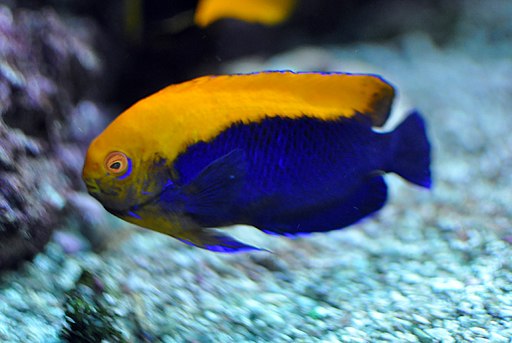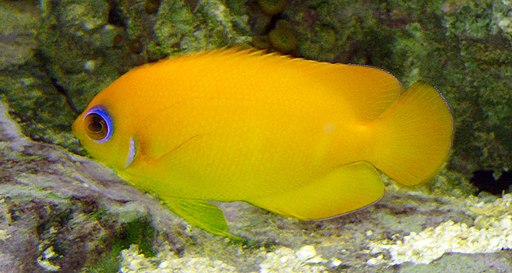Saltwater angelfish are some of the most beautiful, vibrant and active fish you can add to your aquarium. But not all angelfish are reef safe or appropriate for a mixed saltwater tank. Here is a list of the 13 best reef safe angelfish for a saltwater tank.
There are two main groups of saltwater angelfish:
- Dwarf species
- Large/full-sized species
This article will provide you with an overview of the reef safe angelfish species from each of the two main groups.
Reef safe with caution
It is worth noting that all of the saltwater Angelfish species in this article should be considered reef safe with caution. The caution is advised because some individual specimens from just about every angelfish species might occasionally pick at coral polyps or fleshy clam mantles.
Most of the time, everything works out just fine, but there is a chance, with any angelfish, that they acquire such a strong affinity for the live food in your tank that they may actually be incompatible with your reef.
So it is recommended that you watch a newly introduced Angelfish closely to make sure it is not damaging your prized corals–and to remove it if it is. But again, those issues should be the exception, rather than the rule, so let’s get on with the list and exploring these amazing animals further.
| Common name (dwarf) | Scientific name | Adult size | Tank size | Difficulty |
| 1. Bicolor angelfish | Centropyge bicolor | 6 in. | 55 gallons | Medium |
| 2. Cherub angelfish | Centropyge bicolor | 3 in. | 55 gallons | Medium |
| 3. Coral Beauty angelfish | Centropyge bispinosa | 4 in. | 70 gallons | Easy |
| 4. Flame angelfish | Centropyge loricula | 4 in. | 70 gallons | Medium |
| 5. Flameback angelfish | Centropyge acanthops | 3 in. | 55 gallons | Medium |
| 6. Lemonpeel angelfish | Centropyge flavissima | 5.5 in. | 70 gallons | Medium |
| 7. Rusty angelfish | Centropyge ferrugata | 4 in. | 70 gallons | Medium |
| Common name (large) | Scientific name | Max size | Tank size | Difficulty |
| 8. Emperor angelfish | Pomacanthus imperator | 15 in. | 220 gallons | Expert |
| 9. Larmark’s angelfish | Genicanthus lamarck | 9 in. | 125 gallons | Medium |
| 10. Queen angelfish | Holacanthus ciliaris | 18 in. | 250 gallons | Medium |
| 11. Regal angelfish | Pygoplites diacanthus | 10 in. | 125 gallons | Medium |
| 12. Scribbled angelfish | Chaetodontoplus duboulayi | 10 in. | 180 gallons | Medium |
| 13. Swallowtail angelfish | Genicanthus semifasciatus | 8 in. | 125 gallons | Medium |
Reef safe Angelfish: Dwarf species
The Dwarf Angelfish species tend to stay under 5 inches in total length, even as adults. The smallest of the Dwarf angels, the Pygmy or Cherub angel, can be kept in a tank that is at least 55-gallons, while the rest of the group requires a tank that is at least 70 gallons in volume.
1. Bicolor angelfish
The Bicolor angelfish is a very popular saltwater angelfish. Just look at the coloration below and you’ll see why.

The Bicolor angelfish is considered to be a reef safe angelfish with caution. It is one of the largest Dwarf angels and will grow to about 6 inches in length. It requires a tank size of 70-gallons or larger.
2. Cherub angelfish
Cherub angelfishes are an absolute delight to watch in a tank, because they never stop swimming. They are little blue and yellow electric bundles of energy.

The Pygmy, or Cherub Angelfish is a reef safe angelfish that will only grow to about 3 inches in total length, even as a fully-grown adult. They will be happy in any tank that is 55-gallons in volume or larger.
Most of the individual Cherub’s that I have seen have had even brighter yellow-faces than the one shown in the image above, making them quite popular and attractive. They are one of my favorite of the dwarf angelfish on this list and are a species I have cared for in my own tanks.
3. Coral Beauty angelfish
The Coral Beauty Angelfish boasts electric blues, oranges that look like a sunrise and also purple colors. They are hardy and relatively commonly available, which makes them a big hit for saltwater aquarium owners.

The Coral Beauty Angelfish grows to a total length of 4 inches as an adult and requires a tank of 70-gallons or larger.
At the time of this article, i have a beautiful individual zipping around my own tank.
4. Flame angelfish
The Flame angelfish is a show-stopping stunner. Vibrant red/orange hues with purple and black accents will make this fish the envy of your friends.

The Flame angel grows to a maximum size of 4 inches in length and requires plenty of space to swim around. A 70-gallon tank is the recommended minimum size for this fish.
I have had the good fortune to care for these elegant beauties a couple of times (remember, I’ve been doing this for many, many years). I have found them to be a bit more delicate than the Cherub or the Coral Beauty, but they are exponentially more colorful.
5. Flameback angelfish
The Flameback angelfish is an extremely popular option because of the gorgeous coloration (see the image below) as well as because of their small size. They are a Pygmy dwarf angel and only grow to a maximum size of 3 inches in length as adults.
Because of their relatively small size, even as adults, the Flameback Angelfish can be successfully kept in a saltwater aquarium that is 55-gallons or larger.
6. Lemonpeel angelfish
Perhaps the most “appealing” reef safe angelfish on this list is the Lemonpeel angelfish. They are a bright, canary yellow throughout most of their body, with electric blue accents around the eyes and gill plate.
Lemonpeel grow to a maximum size of 5 inches and require a 70-gallon aquarium. They are well loved and admired because of their own individual beauty, and also because of their association with a fish called the Mimic Tang, which exhibits an evolutionary adaptation called mimicry to try to fit in with schools of Lemonpeel angels to avoid predation.
Learn more about mimicry here.
7. Rusty angelfish
The rusty angelfish is a hardy and inexpensive option that is great for those who want to get some experience raising reef safe angelfish species without breaking the bank.
The the main colors are a little bit more subdued, when compared with a few other species on this list, but they do still boast the sunrise orange accents you will see in the Coral Beauty or Flame Angelfish, as well as some of the electric blue highlights common across several other species.
The Rusty angelfish will grow to about 4 inches in total length as an adult and requires a tank volume of at least 70-gallons due to their active swimming.
Reef safe Angelfish: Large species
There are several larger angelfish that come with the description: reef safe with caution. Caution means…they may be alright and leave your corals alone…but then again…they might not.
Be sure to acclimate them fully to aquarium prepared foods in quarantine before adding them to your display tank with corals and watch your tank carefully, separating them from the corals if you see an issues.
9. Emperor angelfish

The Emperor Angelfish grows to a full size of 15 inches in length and requires a 220 gallon tank volume, due to their large size.
8. Lamarck’s Angelfish

Lamarck’s Angelfish grows to 9 inches in length and requires a tank that is at least 125 gallons in volume.
10. Queen angelfish

The Queen Angelfish, Holacanthus ciliaris is an omnivore, just like most of the other angels in this list. They grow quite large–18 inches, in fact, and require a tank that is at least 250 gallons in volume.
11. Regal angelfish
The Regal Angelfish is probably the most gorgeous fish on this list, at least in my own personal opinion, which is a shame, because it is also one of the hardest fish to care for on this list.

Regal Angelfish grow to be about 10 inches and require 180 gallons of swimming room to be happy and healthy.
12. Scribbled angelfish

The Scribbled angelfish is considered to be a reef safe angelfish species. They grow to be about 10 inches in length when fully-grown and require a tank volume of at least 180 gallons.
13. Swallowtail angelfish
The Swallowtail Angelfish grows to about 8 inches as an adult and requires 125 gallons of aquarium volume to swim and be happy.
Conclusions
Reef safe, with just about any of the types of Saltwater Angelfish species, means probably, hopefully, will leave fleshy coral polyps and clam mantels alone, but it is not guaranteed. That’s why the recommendation always comes with a disclaimer like, caution advised or with some caution.
If you keep your individuals fed well and acclimate them well to prepared aquarium foods–and if you have reasonable, perhaps even average luck, you should be fine.
But buyer beware, there are warnings with most of the fish on this list that there may come a time when they do decide to munch a bit on your corals. So watch carefully and take action (separating the fish from the corals), if you see any issues.
I can share that I’ve had personal experience with a few different individual Cherub, Flame, and Coral Beauty angelfishes, all of which have been completely reef safe.
What to read next
- The most colorful saltwater fish
- 20 Most popular saltwater fish
- French angelfish care guide
- Majestic angelfish care guide






Leave a Reply